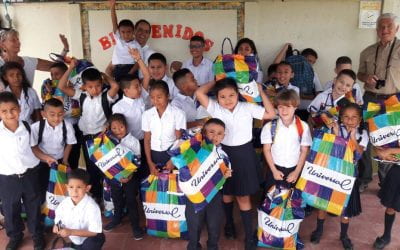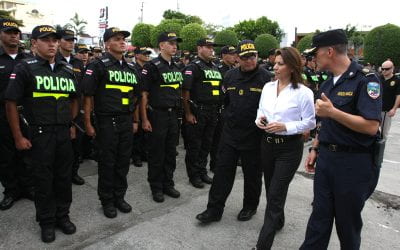Costa Rica and “the Others”
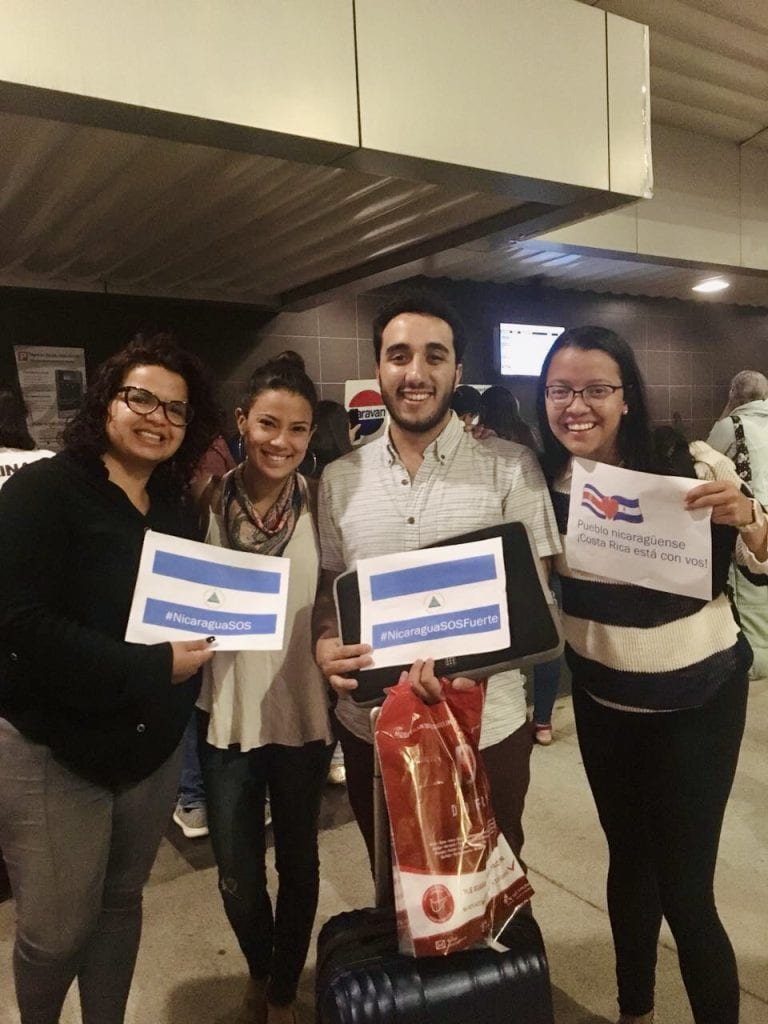
My Costa Rican friends welcoming me at the airport in 2018. Photo: Cindy Regidor
I never felt myself to be the “other” until I emigrated to Costa Rica. I’d never imagined that leaving one’s own country to install oneself in a foreign land redefines identity, and, sometimes, even one’s purpose in life. At least, that’s what happened in my case.
I arrived in 2015 from Nicaragua to this neighboring Central American country with a suitcase filled with illusions about this new stage of life I was beginning along with my husband as a result of his work transfer. He is Canadian and I’m Nicaraguan, and together we began, bit by bit, as foreigners, discovering and falling in love with our new home: this small paradise visited by millions of people from around the world each year, because of its exuberant and green nature, as well as its reputation as the region’s role model—one of the few countries in the world without an army and with a prolonged history of democracy, peace and stability.
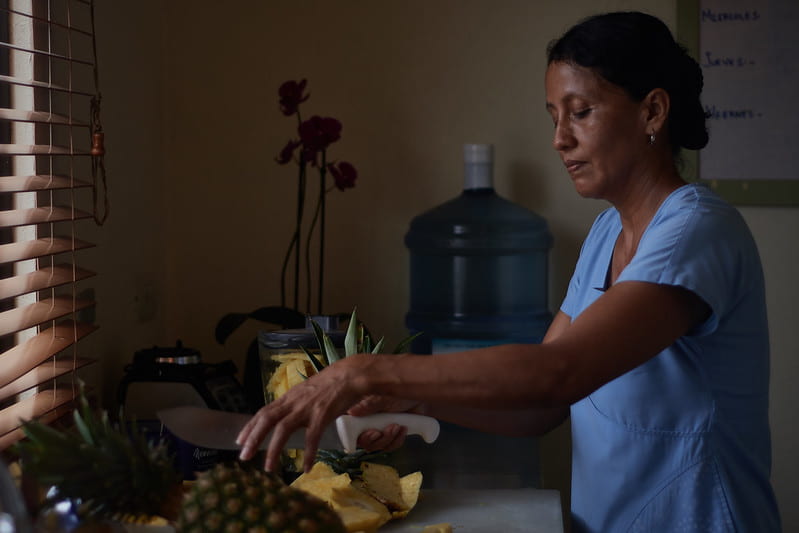
A Nicaraguan woman who works as a janitor in Upala, Alajuela. Photo: Confidential
But, in the suitcase, I also carried certain doubts. After all, Costa Rica was also a place where at least 300, 000 fellow countrymen had arrived before me for decades, fleeing poverty, dictatorships, a civil war, earthquakes and hurricanes. In the news, I’d read that these migrants sent remittances to family members in Nicaragua. I’d also heard about the mistreatment some suffered just because they were Nicaraguan, about hostility between Nicas and Ticos (as Costa Ricans are called) because of political tensions along the border; I heard about the exploitation of those who came seeking work in the coffee or pineapple fields or as security guards, maids and construction workers.
We were “the others,” the largest foreign population in the country, arriving to do the jobs that the average Tico, with better education and resources, no longer wanted to do. We were, for some, the poor, brown-skinned, simple, inferior, but also sometimes perceived as criminal threats. There’s even a popular saying, “Don’t act like a Nica,” as Carlos Sandoval, an expert on migratory themes, explains.
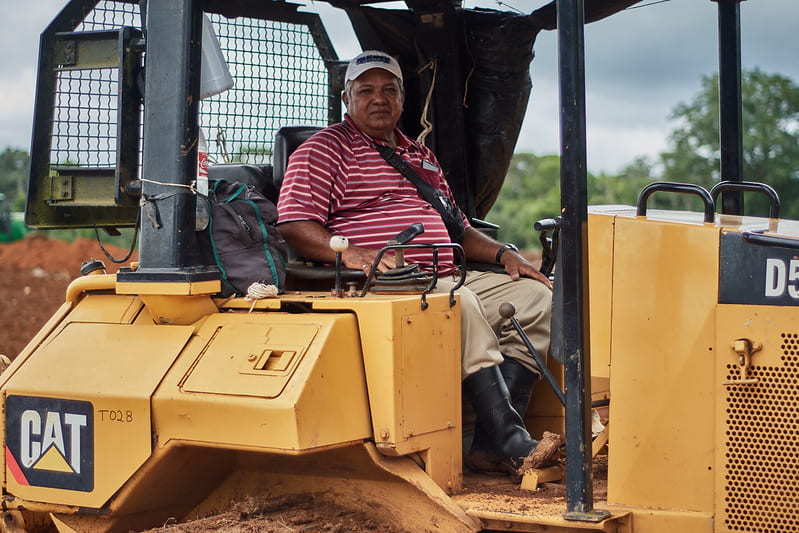
Nicaraguan worker on a pineapple cultivation farm in Upala, Alajuela. The Nicaraguan workforce in agricultural activities in Costa Rica is significant and fundamental in several areas, such as the coffee and pineapple harvest Photo: Confidencial
In 2005, this hostility reached its peak when an indigent Nicaraguan, Natividad Canda, was torn to pieces by three dogs when he trespassed in a car repair shop to rob aluminium; police and others who witnessed the attack stood by and did nothing, according to media reports. The event set off heated debates and xenophobic expressions about Nicaraguan migrants in Costa Rica.
Ten years later when I arrived, the mood seemed more friendly, at least in my social environment. What I did find were micro-aggressions of “furtive xenophobia,” as a Nicaraguan college student recounted when I interviewed her in my first months here. I remember the surprise of some Costa Ricans when they found out I was Nica and spoke fluent English. I received “compliments” such as “Oh, you’re Nica, but you express yourself very well” or “Oh, you’re Nicaraguan? You don’t seem to be.” And, of course, at the same time, there were—and are—aggressions, insults and open xenophobic attacks suffered by other Nicaraguans, generally those in disadvantaged economic and social conditions, because xenophobia goes hand-in-hand with racism and class discrimination here and in all parts of the world.
Class, race and nationality figures into how foreigners are treated in Costa Rica, differences that become more evident in contrasting the experience of Central American migrants with that of those from Europe and the United States who settle in a permanent fashion in the more touristic zones. These “expats,” as they call themselves, to differentiate from other migrants, who come to Costa Rica to retire, to buy houses or start businesses, are generally well-received and there’s seldom any discriminatory expressions against them in the public debate.
The government has recently promoted a law for digital nomads, intended to attract, especially after the pandemic, foreigners earning at least US$3,000 monthly who wish to live and work remotely in Costa Rica.
There’s a saying that, supposedly, reflects a certain Costa Rican idiosyncrasy: “A Tico invites you home, but never gives you the address,” a refrain repeated with a sense of humor even by Costa Ricans themselves. I have very good Tico friends, who indeed gave me their addresses. They are people interested in understanding my reality as a migrant and a Nicaraguan, with whom I have created strong bonds based on admiration and mutual respect.
The kindness, solidarity and genuine welcome of the majority of Costa Ricans through moving gestures caused my reservations to dissipate. I remember, for example, the night of April 20, 2018, when I had to interrupt a visit to Managua because of the beginning of the massive citizens’ protests that were brutally repressed by the Daniel Ortega-Rosario Murillo regime. Chaos had taken over Nicaragua. Yet that night was only the beginning of long and exhausting months that have become six years of a serious socio-political and human rights crisis. When I returned to Costa Rica scared and with an aching heart, Costa Rican friends met me in the airport with signs of support and warm hugs.
I wasn’t the only one the Ticos gave their welcome to at that time. In 2018, Costa Rica became, together with the United States, one of the main destinations for the tens of thousands of Nicas who had fled because of the repression and the economic crisis resulting from politics.
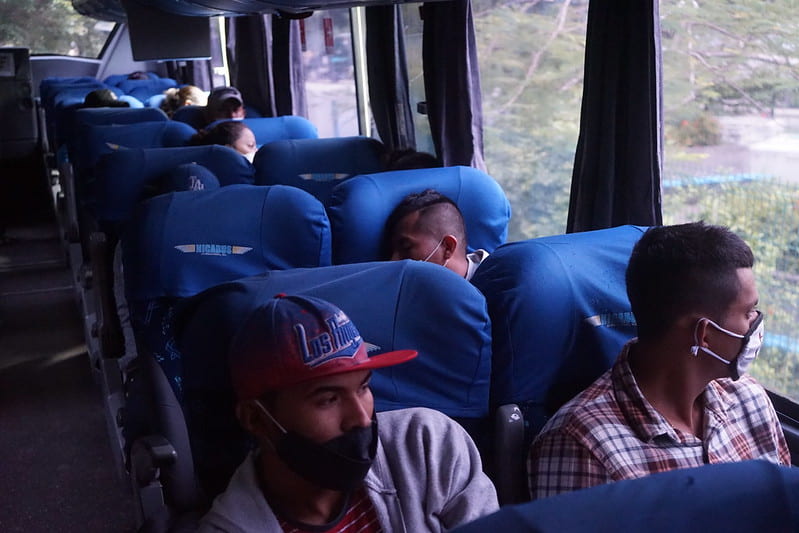
Nicaraguans arrive in buses at the border of Costa Rica with Nicaragua as part of a coffee harvesting program. Photo: Cindy Regidor | Confidencial
Over time, my migrant identity and my journalistic identity joined forces to feel the necessity of narrating the experiences of those Nicaraguans who, leaving their homeland, became invisible and stereotyped “others.” We had to say who we were and how we were experiencing life in our new homes, we had to show how we were part of Nicaraguan society and part of the society that had taken us in, and we had to extend a bridge so the Nicas inside and outside the country would recognize each other. I assumed this mission as a personal cause.
Through the intense coverage we have developed in Nicas Migrantes of Confidencial, an online Nicaraguan newspaper publishing in exile from Costa Rica, I’ve been able to see up close the Costa Rican duality in its treatment of foreigners, who now make up 15% of its total population of five million.
In spite of being an important population for its size and economic contributions, adding more that 12% to the Gross Domestic Product (GDP), according to estimates by the Organisation for Economic Cooperation and Development (OCED) and the International Labour Organization (ILO), at the present time, a clear and consistent policy for migration and integration is non-existent,nor has one been discussed in the past few years, as it is pointed by Daguer Hernández, the assistant director of the Office of Migration and Foreign Nationals (DGME) between 2018 and 2022.
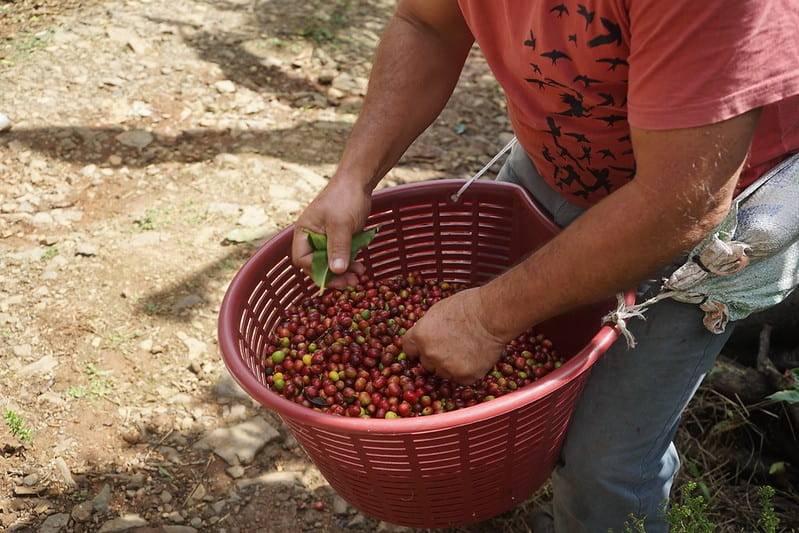
The seasonal migrant labor force, the vast majority of which is Nicaraguan, corresponds to 60%, that is, more than 45,000 coffee bean pickers. Photo: Cindy Regidor | Confidencial
Indeed, Costa Rica has a historic tradition of taking in asylum seekers and refugees of different nationalities, a fact that is confirmed by the 200,000 requests for refugee status that have accumulated since 2018, most of them from Nicaraguans. But, unfortunately, that is not enough.
Because of the enormous quantity of requests, the Unit for Refugees will take many years to process them and, in the meantime, those in the country with pending asylum cases, find themselves coping with the obstacles established at the end of 2022 by President Rodrigo Chaves, who asserted that economic migrants were taking advantage of the asylum system.
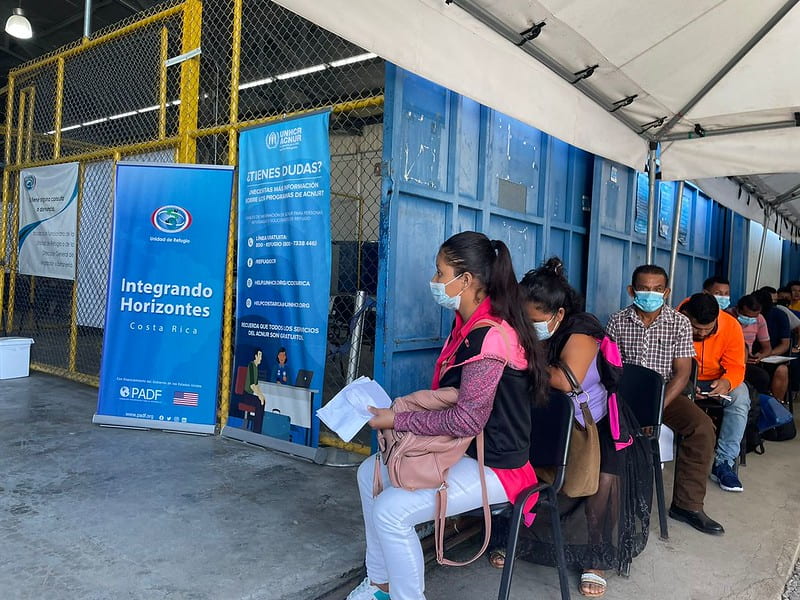
Refugee seekers line up at the Refuge Unit of the Directorate of Migration and Immigration of Costa Rica. Photo: Cindy Regidor | Confidencial
Before that, he had complained that these migrants were a burden and that the international community was not providing enough support through donations to take care of them.
This rhetoric from the position of power that categorizes migrants as a burden is mistaken, since those economic migrants not only are an important percentage of the productive work force in several sectors of the Costa Rican economy, but they also pay taxes and cover the costs of living in the country, which is the most expensive in Central America. These migrants who come to work do not have easy access to state assistance unless they have legal migratory status. As a matter of fact, those migrants with irregular status are exploited or their laboral rights are not recognized. Frequently, their bosses do not enroll them in the Costa Rican Social Security Fund, the public health system that only takes care of its insured members, with the exception of children and pregnant women, who are treated independently of their nationality or migration status. President Chaves’ declaration also did not take into account that Nicas are an essential work force in the production of products such as pineapple (Costa Rica is the top exporter in the entire world), or in the coffee harvest (known internationally for its high quality), as well as in many other areas of the economy.
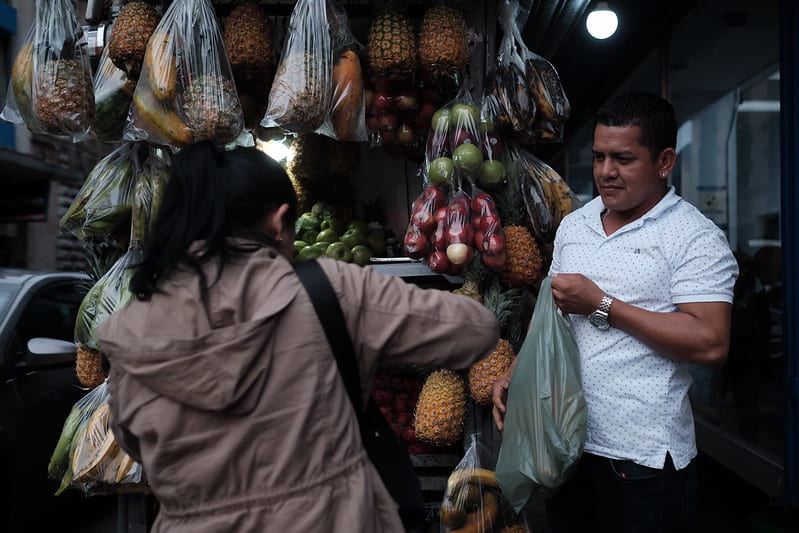
Nicaraguans also participate in the commerce sector. In the photo, a Nicaraguan fruit merchant in the center of the capital San José. Photo: Confidencial
A migratory policy that seeks to achieve the integration of the foreign population would pursue a massive legalization of status so that authorities could have an exact and complete record of who lives in the country. It would permit migrants to work in a formal manner with complete rights and obligations, as Hernández has urged. Unfortunately, 25 years have gone by since the last massive legalization of immigrants in Costa Rica, when in 1999, Central American migrants received amnesty as a humanitarian gesture, after Hurricane Mitch reaped its destruction on the isthmus.
In January, the government announced the creation of a National Migration Strategy, which hopefully will be the integrated response we all long for.
When I first arrived in Costa Rica, I noticed there was very little media representation of the Nicaraguan immigrants. Despite the fact we were everywhere, as workers, neighbors and family, the Nicaraguan population was quite invisible, and if we were mentioned, it was frequently stereotyped and negative. It seemed strange to me, for example, that the largest and most important newspaper in the country didn’t have a section on migration, since Costa Rica is one of the Latin American nations with the greatest number of immigrants relative to its size. There are also no disaggregated official statistics that take into account in a particular and deep manner how the characteristics of migrants impact the quality of life of most residents.
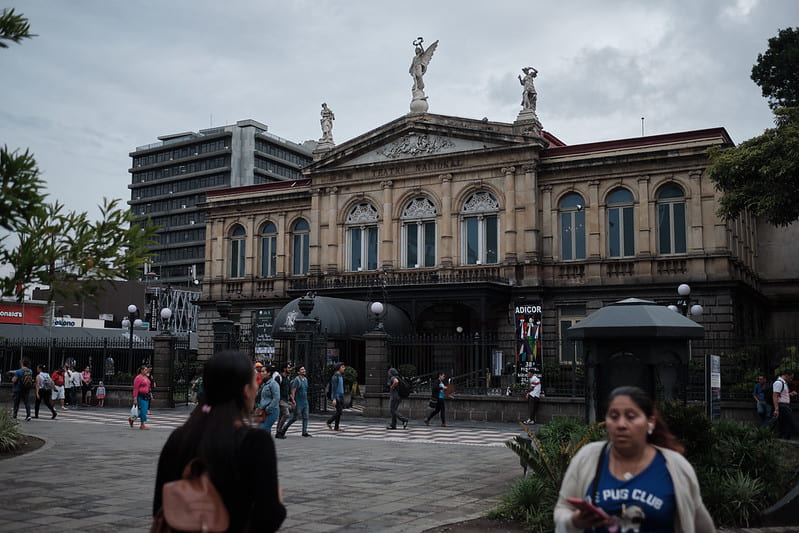
Photo of the National Theater, one of the most important buildings in the center of the capital. Photo: Confidential
During the most recent electoral campaigns, I also didn’t see any special emphasis on the migratory issue, and in the 2022 election, only one political party included the immigrant population, together with Costa Ricans, across the board and in an explícit manner, in its platform. A fortunate difference between Costa Rica and other countries is that, as yet, there have been no election campaigns in which candidates stoke xenophobia, a current trend in the United States and Europe, where populisms use migrants as a scapegoat for all of society’s evils.
For Alberto Cortés Ramos, professor at the Universidad de Costa Rica (UCR), the gap in integration of immigrants occurs because Costa Rica defines its citizens in terms of their nationality and not by the act of residing in its territory. I would add here that, perhaps, another obstacle to full integration of migrants, is the existence of an overwhelming nationalism that doesn’t leave room to celebrate the plurality and integration of other cultural identities although, as a matter of fact, through decades of this flow of Nicaraguan migrants, we have seen an increasing blend of our ways of talking, our food and traditions, and even more important, our people. We see it in the daily coexistence of neighbors, friends and colleagues, the thousands of binational families—Nica and Tico—that have been formed over the decades.
I ask myself if, perhaps, some Costa Ricans, in considering the country “different” or “exceptional,” unconsciously reject the idea of a deeper consolidation with the immigrant population, in its majority Nicaraguan, because this would imply being more like the rest of Central Americans. Iván Molina, a UCR historian, explains, precisely, that Costa Rican identity costarricense “is constructed against the mirror image of the rest of Central America.” The so-called myth of Costa Rican whiteness, mentioned in Molina’s article, still exists, although with less force. There was a time, Molina points out, when asked why Costa Rica was different from Central America, the answer was inevitable “because Costa Rica is white.” What is certain is, like the rest of its neighbors on the isthmus, Costa Rica is mixed race and multicultural. In 2015, the Costa Rican constitution recognized the country as “multiethnic and multicultural,” an important advance in its self-perception as a diverse nation.
But I remain optimistic and I return to those gestures that have moved me and say a lot about the Ticos. In 2018, with the massive arrival of Nicaraguans, a xenophobic and violent protest took place in La Merced, a San José park known as the “park of the Nicas.” I remember the worry and fear of many Nicaraguans, but also the outrage of many Costa Ricans, which was manifested both in actions and words. A few days later, there was a huge counter-protest to the anti-immigrant demonstration, and hundreds of people with Nicaraguan and Costa Rican flags marched along the main streets of San José, chanting, “Side by side, hand in hand: Ticos and Nicas are brothers!” This, for me, is the best way of saying how Costa Ricans are different. And I want to hang on to that difference: worthy of celebration and imitation.
Cindy Regidor is is the founder and editor of Nicas Migrantes in Confidencial. A Nicaraguan journalist based in Costa Rica since 2015, she has 16 años of experience in the print and digital media, as well as television. She has a Master’s in Communication and Studies of Peace and Conflict. E-mail: cindy.regidor@gmail.com
Costa Rica y “los otros”
Por Cindy Regidor
El recibimiento de mis amigos costarricenses en el aeropuerto en 2018. Foto: Cindy Regidor
Nunca me había sentido “la otra” sino hasta que emigré a Costa Rica. No había pensado en cómo salir del país propio para instalarse en uno ajeno redefine la identidad y, a veces, hasta el propósito de vida. Al menos así fue en mi caso.
Llegué en 2015 de Nicaragua al vecino país centroamericano con una maleta llena de ilusiones por la nueva etapa que empezaba junto con mi esposo cuando a él lo trasladaron por su trabajo. Él canadiense y yo nicaragüense, fuimos, poco a poco, como extranjeros, descubriendo y enamorándonos del nuevo hogar: ese pequeño paraíso visitado por millones de personas de todo el mundo, año con año, por su exuberante y verde naturaleza, el mismo que destaca como modelo a seguir en la región, por ser de las pocas naciones del mundo sin un ejército y por su prolongada historia de democracia, paz y estabilidad.

Una mujer nicaragüense que trabaja como conserje en Upala, Alajuela. Foto: Confidencial
Pero, en la maleta también llevaba conmigo algunas reticencias. Después de todo, Costa Rica también era el lugar al que habían llegado antes que yo, y durante décadas, unos 300 000 compatriotas huyendo de la pobreza, de dictaduras, de una guerra civil, de terremotos y huracanes.
En las noticias leía que de Costa Rica llegaban a Nicaragua los dineros que ahorraban esos migrantes para enviar a sus familiares. También escuchaba acerca del maltrato que sufrían algunos por ser nicaragüenses, de la hostilidad entre nicas y ticos (como llaman y se identifican a sí mismos los costarricenses) por las tensiones políticas fronterizas, oía sobre la explotación que sufrían quienes venían a buscar trabajo en los campos de piña y café, como guardas de seguridad, empleadas domésticas o albañiles.
Éramos “los otros”, la población extranjera más grande que llegaba a hacer los oficios que ya el tico promedio, con mayor educación y recursos, no quería hacer. Éramos, para algunos, los pobres, morenitos, sencillos, inferiores, pero también los amenazantes que llegaban a delinquir. Persiste, desde entonces, una frase popular que usan algunos costarricenses para censurar algún comportamiento: “No sea nica”, explica el investigador especializado en temas migratorios, Carlos Sandoval.

Nicaragüense trabajador en una finca de cultivo de piña en Upala, Alajuela. La mano de obra nicaragüense en las actividades agrícolas en Costa Rica es significativa y fundamental en varios rubros, como la cosecha del café y la piña Foto: Confidencial
En 2005 se vivió uno de los puntos más álgidos de esa hostilidad en Costa Rica, cuando un nicaragüense en estado de indigencia, Natividad Canda, murió despedazado por tres perros tras ingresar ilegalmente a un taller de carros para robar aluminio, y ante la pasividad de policías y otros que presenciaron el hecho, reportaron los medios. El hecho detonó fuertes debates y expresiones xenófobas sobre los migrantes nicaragüenses en Costa Rica.
Diez años después, el ambiente parecía más amigable, al menos en mi entorno y para mí, como mujer joven profesional en Periodismo. Lo que hallé fueron micro-agresiones o “xenofobia solapada”, como la describió una joven nicaragüense universitaria a la cual entrevisté en mis primeros meses aquí. Recuerdo el asombro de algunos costarricenses cuando se enteraban de que era nica y hablaba inglés, también “cumplidos” como: “Ah, es nica, pero usted habla bonito”, “¿Es nica?, pero no pareciera”. Por supuesto, a la vez, había y hay, aún, agresiones, insultos, y ataques fuertes y abiertamente xenófobos que sufren otros nicaragüenses, por lo general en condiciones económicas y sociales desventajosas, porque la xenofobia se acompaña de racismo y clasismo aquí y en todas partes del mundo.
Esta diferenciación entre cómo unos y otros extranjeros son percibidos y tratados según clase, raza y nacionalidad, en Costa Rica es más evidente al contrastar la experiencia de los migrantes centroamericanos con la de los estadounidenses y europeos que se asientan de manera permanente en las zonas más turísticas, los “expats”, como se llaman a sí mismos para diferenciarse del resto de migrantes. Estos últimos, que llegan a jubilarse, comprar casas o a poner un negocio, son usualmente mejor recibidos y rara vez hay en el debate público expresiones discriminatorias en su contra. Además, las autoridades han promovido recientemente una ley de nómadas digitales, orientada a atraer, sobre todo tras la pandemia, a extranjeros que deseen vivir y trabajar de forma remota en Costa Rica y ganen al menos 3000 dólares al mes.
Hay un dicho que, supuestamente, retrata parte de la idiosincrasia costarricense: “Un tico te invita a su casa, pero no te da la dirección para llegar”, repiten los mismos ticos con humor. Tengo amigos muy queridos, ticos y ticas, que sí me dieron la dirección de su casa. Son personas interesadas en entender mi realidad como nicaragüense y migrante, con quienes he creado vínculos fuertes basados en la admiración y el respeto mutuos.
La gentileza, solidaridad y la auténtica bienvenida de la gran mayoría de costarricenses a través de gestos conmovedores hicieron que mis reservas fueran desapareciendo. Recuerdo, por ejemplo, la noche del 20 abril de 2018, cuando debí interrumpir una visita a Managua, tras el inicio de las masivas protestas ciudadanas que fueron reprimidas brutalmente por el régimen de Daniel Ortega y Rosario Murillo en Nicaragua. Para entonces el caos ya se había apoderado del país entero. Era tan solo el inicio de largos y agobiantes meses que se han convertido en seis años de una seria crisis sociopolítica y de derechos humanos. Al regresar a Costa Rica con el corazón revuelto y asustado, me esperaban en el aeropuerto amigos costarricenses con carteles de apoyo y cálidos abrazos.
No fui la única a la que recibieron los ticos en ese momento. Costa Rica se convirtió a partir de ese año, junto con Estados Unidos, en uno de los principales destinos de decenas de miles de nicas que han huido por la represión y el deterioro económico derivado de la situación política.

Nicaragüenses arriban en buses a la frontera de Costa Rica con Nicaragua como parte de un programa de labores de cosecha de café. Foto: Cindy Regidor | Confidencial
Con el tiempo, mi yo migrante y mi yo periodista decidieron que había que narrar las experiencias de esos nicaragüenses que, al salir de su patria, se convertían a menudo en los otros invisibilizados o estereotipados. Había que contar quiénes éramos y cómo la estábamos pasando en los lugares de acogida, había que retratarnos como parte de la sociedad nicaragüense y como parte de las sociedades que nos acogen, y había que tender un puente para que se reconocieran los nicas de adentro y los de afuera. Asumí esta misión como una causa personal.
Gracias a la intensa cobertura que hemos desarrollado desde Nicas Migrantes de Confidencial, uno de decenas de medios digitales que operan desde el exilio en Costa Rica, he podido ver de cerca las dualidades costarricenses en su trato hacia la población extranjera, que actualmente constituye cerca del 15% del total de cinco millones de habitantes.
A pesar de ser una población importante por su tamaño y sus contribuciones económicas, con un aporte al PIB de más de 12%, según cálculos de la Organización para la Cooperación y el Desarrollo Económicos (OCDE) y la Organización Internacional del Trabajo (OIT), actualmente no hay una política migratoria y de integración clara ni consistente, ni la ha habido en los últimos años, tal y como lo señala Daguer Hernández, quien fungió como subdirector de la Dirección de Migración y Extranjería (DGME) entre 2018 y 2022.

La fuerza laboral migrante estacional, en su gran mayoría nicaragüense, corresponde al 60%, es decir más de 45 000 recolectores del grano de café. Foto: Cindy Regidor | Confidencial
Sí es verdad que Costa Rica tiene una tradición histórica de acogida de solicitantes de refugio y refugiados de distintas nacionalidades, y así se confirma con la recepción de más de 200 000 solicitudes de refugio que se han acumulado desde 2018, la gran mayoría de nicaragüenses. Pero, lamentablemente, ello no es suficiente.
Debido a la enorme cantidad de solicitudes, a la Unidad de Refugio le tomará muchos años resolverlas y, mientras tanto, quienes se hallan en el país como solicitantes de asilo, lidian con las trabas establecidas a finales de 2022 por el presidente Rodrigo Chaves, quien alegó que había migrantes económicos aprovechándose del sistema de refugio. Antes se había quejado de que estos migrantes eran una carga y de que la comunidad internacional no estaba apoyando lo suficiente con donaciones para atenderles.

Solicitantes de refugio hace fila en la Unidad de Refugio de la Dirección de Migración y Extranjería de Costa Rica. Foto: Cindy Regidor | Confidencial
Esa retórica desde el poder que posiciona a los migrantes como carga es errada, pues esos migrantes económicos no solo son un importante porcentaje de la fuerza productiva en los distintos sectores económicos costarricenses, sino que, además, pagan impuestos y cubren todos sus gastos para vivir en este país, que es el más caro de Centroamérica. Estos migrantes laborales no pueden acceder fácilmente a programas estatales de asistencia, menos si no tienen un estatus migratorio regular. De hecho, los migrantes en condición irregular muchas veces son explotados o sus derechos laborales no son reconocidos. Es común que los patronos no les inscriban ante la Caja Costarricense del Seguro Social, el sistema de salud público que solo atiende a asegurados, y, a niños y embarazadas sin importar su nacionalidad o condición migratoria. Esa apreciación del presidente Chaves también deja por fuera que los nicas son mano de obra imprescindible en la producción de productos como la piña (Costa Rica es el principal exportador del mundo), o en la cosecha de café (apreciado por su gran calidad a nivel internacional), entre muchos otras áreas de la economía.

Los nicaragüenses también participan en el sector del comercio. En la foto, un nicaragüense comerciante de frutas en el centro de la capital San José.
Una política migratoria con miras a lograr la integración completa de la población extranjera procuraría la regularización masiva, de manera que las autoridades tengan un registro exacto y completo de quienes habitan el país, y permitiría a los migrantes trabajar de manera formal, con todos sus derechos y obligaciones, como bien lo argumenta Hernández. Desafortunadamente, han pasado 25 años desde la última regularización masiva de migrantes en Costa Rica, cuando en 1999 se otorgó una amnistía a migrantes centroamericanos como un gesto humanitario, luego del paso destructivo del Huracán Mitch por el istmo. En enero, el Gobierno anunció la creación de una Estrategia Nacional de Migración, ojalá sea la respuesta integral que muchos anhelamos.
Al llegar a Costa Rica, noté también que había muy poca representación mediática de los migrantes nicaragüenses. A pesar de que estábamos presentes en todas partes, como trabajadores, vecinos y familia, había poca visibilidad de la población nica o bien, si la había, era con frecuencia estereotipada y negativa. Me pareció extraño que no hubiese, por ejemplo, una sección sobre migración en el periódico más grande e importante del país, siendo esta una de las naciones latinoamericanas con mayor proporción de migrantes entre sus habitantes. Tampoco hay estadísticas oficiales desagregadas que consideren de manera particular y profunda cómo la característica de ser migrante impacta la calidad de vida de una buena parte de los habitantes.

Foto del Teatro Nacional, uno de los edificios más importantes del centro de la capital. Foto: Confidencial
Durante las más recientes campañas electorales tampoco he visto especial énfasis en el tema migratorio, y solo encontré en la elección de 2022 a un partido que incluyó de forma transversal y explícita a la población migrante, junto a costarricenses, en su plan de gobierno. Una diferencia afortunada entre Costa Rica y otros países en este aspecto es que, hasta hoy, no han habido campañas electorales en que los candidatos aticen la xenofobia, una tendencia actual en Estados Unidos y Europa, donde los populismos colocan a los migrantes como chivo expiatorio de los males que aquejan a las sociedades.
Para el catedrático de la Universidad de Costa Rica (UCR), Alberto Cortés Ramos, la brecha en la integración de los migrantes ocurre porque Costa Rica define a su ciudadanía a partir de la nacionalidad de las personas y no de quienes habitan su territorio. Yo agregaría que, quizá, otro impedimento para la plena integración de los migrantes, es la existencia de un nacionalismo arrollador que no da espacio para celebrar la pluralidad y la integración de otras identidades culturales aunque, en realidad, tras décadas de ese flujo importante de migrantes nicaragüenses, vemos que cada vez más se fusionan nuestras formas de hablar, nuestras comidas y tradiciones, y, más importante aún, nuestros pueblos. Así lo vemos en la convivencia cotidiana de vecinos, amigos y colegas las miles de familias binacionales que se han conformado a lo largo de las décadas.
Me pregunto si, quizá, algunos costarricenses, al considerar el país “distinto” o “excepcional”, inconscientemente rechazan la idea de una consolidación más profunda con la población inmigrante, mayoritariamente nicaragüense, porque ello implicaría parecerse más al resto de centroamericanos.
Iván Molina, historiador de la UCR, explica en un artículo de la BBC, justamente, que la identidad costarricense “se construye contra el espejo del resto de Centroamérica”. Sobrevive aún el mito de la blanquitud, también mencionado en el artículo periodístico, aunque con menor fuerza. Hubo un tiempo, señala Molina, que para explicar por qué Costa Rica era diferente al resto de países centroamericanos, se aseguraba que era “porque Costa Rica es blanca”. Lo cierto es que es, al igual que sus vecinos en el istmo, un país mestizo y multicultural y, en 2015, así se reconoció en la Constitución, que fue modificada para reconocer a Costa Rica como “multiétnica y pluricultural”, en un avance importante de su auto percepción como nación diversa.
Me gusta mantenerme optimista, volver a esos cambios y revisiones, a los gestos que conmueven y dicen mucho de quienes son los ticos.
En 2018, con la llegada masiva de nicaragüenses, hubo una protesta xenófoba y violenta en La Merced, un parque de la capital conocido como “el parque de los nicas”. Recuerdo la preocupación y el temor de muchos nicaragüenses, pero también la indignación de muchos costarricenses que no solo se quedó en palabras. A los pocos días hubo una respuesta contundente a la manifestación anti inmigrante: por las principales avenidas de la ciudad marcharon cientos de personas que portaban banderas nicaragüenses y costarricenses y que coreaban: “¡Hombro con hombro, mano con mano: ticos y nicas somos hermanos!”. Esa, para mí, es una mejor manera de distinguirse que tienen los costarricenses. Es a la que deseo aferrarme: digna de celebración e imitación.
Cindy Regidor es fundadora y editora de Nicas Migrantes en Confidencial. Periodista nicaragüense basada en Costa Rica desde 2015, tiene 16 años de experiencia en prensa escrita, televisión y medios digitales, y una maestría en Medios de Comunicación, Estudios de Paz y Conflicto de la Universidad para la Paz de Naciones Unidas. Correo electróni
Related Articles
A Review of Alberto Edwards: Profeta de la dictadura en Chile by Rafael Sagredo Baeza
Chile is often cited as a country of strong democratic traditions and institutions. They can be broken, however, as shown by the notorious civil-military dictatorship of Augusto Pinochet (1973-1990). And yet, even a cursory view of the nation’s history shows persistent authoritarian tendencies.
Homecoming and Public Education: The Cancel Culture (of class time) in Costa Rica
When I returned home on my sabbatical, I couldn’t stop thinking about Svetlana Boym’s extraordinary book, El futuro de la nostalgia.
Crisis of Citizen Insecurity in Costa Rica: A Challenge to the Model of Demilitarized Democracy
I began my political and public service career thirty years ago as Minister of Public Security, the first woman to ever hold that post in my country, Costa Rica.


